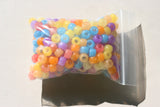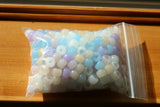Playing with light July 20 2015, 0 Comments
Summer is a great time to play, and I still enjoy playing with my science observations. Light and color are great subjects for exploration. Put it all together and here’s what I’ve been doing.
First of all I ordered a bag of UV beads from Loose in the Lab, a company in Salt Lake City, UT. These beads are available from a number of suppliers on the Internet. They are plain white beads in artificial lighting, but when they are outdoors in sunlight, they turn bright colors. A substance that reacts to something we can’t see and allow us to see it is often called an indicator, and these beads are an indicator of light that has too short a wavelength for us to see.
I noticed one day that these UV beads developed pale colors on the window sill, where the glass should have filtered out any ultraviolet light. Either the window glass was letting in a some UV or the beads were coloring from the shortest of visible wavelengths.
I checked the ability of shorter wavelength visible light to color the beads using a window sill prism that projects a nice spectrum of light across the room. I placed the bag of UV beads in the “rainbow” and saw that the beads in the violet light at the top of the spectrum caused some of the beads to color. The beads that turned blue and purple in sunlight also colored lightly in violet light. None of the beads in red, yellow, green, or blue light changed color.
I also researched window glass transmission of UV light on the Internet. I thought that glass blocked UV, and I found that it does block UVB, the wavelengths that cause sunburn and allow us to make vitamin D in our skin. I was surprised to learn that glass transmits appreciable quantities of UVA, the longer UV wavelengths that age skin and can cause cataracts. It is unlikely that any seating in your classrooms put children in direct sunlight in the middle part of the day because of the heat, but if so, you may want to move them to avoid UVA. Morning and afternoon sun is less intense, so sunlight at that time is not such a hazard.
The beads that colored in the violet part of the spectrum tell me that the shortest wavelengths of visible light will cause color change, and I suspect that the UVA coming through the window is strong enough to change them as well because the colors were stronger on a sunny window sill than in the violet light. The sunlight coming through an acrylic skylight colors the beads quickly, but not as deeply as direct sunlight, so I suspect that the skylight cover transmits a lot of UVA. In case you are wondering, polycarbonate plastic, which is often used in safety glasses, blocks all UV light. Children should have these safety glasses if they use UV or “black” light. Their eyes are specially sensitive to UV damage.
What can children learn out of this experiment? Different wavelengths of light are different colors, and the shorter wavelengths (violet) carry more energy than the longer wavelengths (red). There are wavelengths of light that we can’t see, but other substances allow us to detect them.
Children can address many questions using these beads. They may be interested in the ability of clothing or other items to block UV light. Does UV light come through the clouds? Have fun finding out!



